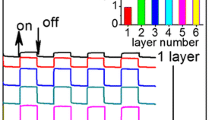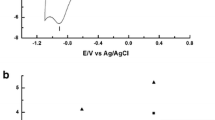Abstract
The effect of substituents with different donor capabilities, which are inserted into a molecule of fullerene C60, on the kinetics and thermodynamics of redox conversions of fullerenes that are immobilized on an electrode, is studied for the first time. To this end, redox conversions that occur with rubbed-on films of fullerene and fulleropyrrolidines are studied using cyclic voltammetry in 0.5 M KCl/H2O and a 0.1 M (C4H9)4NBF4/AN solution in acetonitrile. A hypothesis that the kinetics of redox conversions occurring with films of individual fullerenes is defined largely by changes in the structure of initial films in the process of their cathodic doping is used. The effect of the substituents is explained in the framework of this hypothesis by a transition from a dense crystalline structure of nonsubstituted fullerene C60 to an amorphous structure of substituted fullerenes. It is demonstrated that the formal potentials corresponding to redox conversions of fullerenes in a solid cationic lipid matrix are defined by the energy of interaction of anions, which are products of reduction of fullerenes, with cations of the matrix. As a result of this interaction, the formal potentials of the process of cathodic doping shift to less negative values. It is established that the insertion of a donor substituent and increase in its donor capability amplify the energy of interaction of the fullerene anions with the lipid cations.
Similar content being viewed by others
References
El-Khouly, M.E., Ito, O., Smith, P.M., and D’souza, F., J. Photochem. Photobiol. C, 2004, vol. 5, p. 75.
Guldi, D.M., Chem. Soc. Rev., 2004, vol. 31, p. 22.
Tat, F.T., Zhou, Z., MacMahon, S., Song, F., Rheingold, A.L., Echegoyen, L., Schuster, D.I., Wilson, S.R., J. Org. Chem., 2004, vol. 69, p. 4602.
Gol’dshleger, N.F., Lapshin, A.N., Yudanova, E.I., Alpatova, N.M., and Ovsyannikova, E.V., Elektrokhimiya, 2006, vol. 42, p. 19.
Chlistunoff, J., Cliffel, D., and Bard, A.J., Thin Solid Films, 1995, vol. 257, p. 166.
Song, F. and Echegoyen, L., J. Phys. Chem. B, 2003, vol. 107, p. 5844.
Tan, W.T., Lim, E.B., and Bond, A.M., J. Solid State Electrochem., 2003, vol. 7, p. 134.
Nakashima, N., Kuriyama, T., Tokunaga, T., Murakami, H., and Sagara, T., Chem. Lett., 1998, p. 633.
Nakashima, N., Nonaka, Yu., Nakanishi, T., Sagara, T., and Murakami, H., J. Phys. Chem., B, 1998, vol. 102, p. 7328.
Nakanishi, T., Ohwaki, H., Tanaka, H., Murakami, H., Sagara, T., and Nakashima, N., J. Phys. Chem. B, 2004, vol. 108, p. 7754.
Troshin, P.A., Troyanov, A.I., Boiko, G.M., Lyubovskaya, R.N., Lapshin, A.N., and Goldshleger, N.F., Fuller., Nanotub., Carbon Nanostruct., 2004, vol. 12, p. 43.
Szücs, Á., Tölgyesi, M., Csiszár, M., Nagy, J.B., and Novák, M., J. Electroanal. Chem., 1998, vol. 442, p. 59.
Tan, W.T., Lim, E.B., and Goh, J.K., J. Solid State Electrochem., 2005, vol. 9, p. 30.
Krause, M., Deusch, D., Janda, P., Kavan, L., and Dunsch, L., Phys. Chem. Chem. Phys., 2005, vol. 7, p. 3179.
Krinichnaya, E.P., Moravsky, A.P., Efimov, O.N., Sobczak, K., Winkler, K., Kutner, W., and Balch, A.L., J. Mater. Chem., 2005, vol. 15, p. 1468.
Koh, W., Dubois, D., Kutner, W., Jones, M.T., and Kadish, K.M., J. Phys. Chem., 1993, vol. 97, p. 6871.
Kvarnström, C., Neugebauer, N., Kuzmany, H., Sitter, H., and Sariciftci, N.S., J. Electroanal. Chem., 2001, vol. 511, p. 13.
Nakanishi, T., Morita, M., Sagara, T., and Nakashima, N., Chem.-Eur. J., 2002, vol. 8, p. 1641.
Krishtalik, L.I., Alpatova, N.M., and Ovsyannikova, E.V., Electrochim. Acta, 1991, vol. 36, p. 435.
Author information
Authors and Affiliations
Additional information
Original Russian Text © N.F. Gol’dshleger, E.V. Ovsyannikova, A.N. Lapshin, O.N. Efimov, R.N. Lyubovskaya, N.M. Alpatova, 2006, published in Elektrokhimiya, 2006, Vol. 42, No. 7, pp. 853–861.
Rights and permissions
About this article
Cite this article
Gol’dshleger, N.F., Ovsyannikova, E.V., Lapshin, A.N. et al. Electrochemical behavior of fullerene C60 and substituted fullerenes immobilized on an electrode surface. Russ J Electrochem 42, 767–775 (2006). https://doi.org/10.1134/S102319350607010X
Received:
Issue Date:
DOI: https://doi.org/10.1134/S102319350607010X




